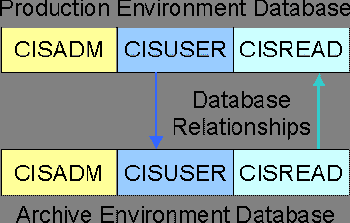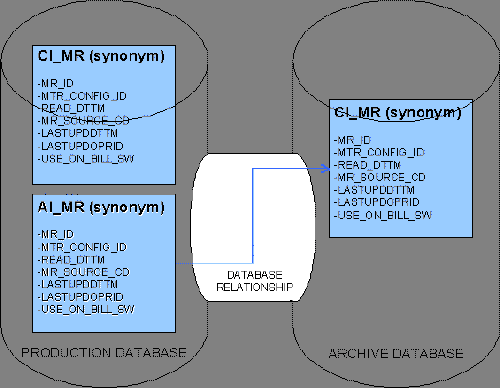When an environment is installed initially, a database user is defined as the owner of all the application database schema objects. We'll call this database user CISADM. To use the archive engine, two additional database users are necessary for each environment's database:
- Database user with read/write access to the application database
schema. We'll call this database user CISUSER.
- This database user is installed automatically when the system is installed in an Oracle database.
- The application server(s) used to access the production environment should be configured to access the production database as the CISUSER database user. This is the default in an Oracle installation. For DB2, this is a manual operation that must be performed manually following installation and prior to environment registration.
- Database user with read-only access to the application
database schema. We'll call this database user CISREAD.
- Note that this database user is installed automatically when the system is installed in an Oracle database.
- The application server(s) used to access the archive environment should be configured to access the archive database as the CISREAD database user.
Prior to registering an Archive environment, the following database relationships must be configured by your implementation's database administrator to match the diagram below:

Notice that the database relationship originating from the production environment's CISUSER database schema references the CISUSER schema in the archive environment's database. A database relationship originating from the archive environment's CISREAD database schema references the CISREAD schema in the production environment's database.
Archive database processes that are run from the production environment move data into a given archive environment. When the process populates tables in an archive environment's database, the CISUSER to CISUSER database relationship is used.

So that archived data may be viewed along with production data in an archive environment, the registration script creates super views of application tables by defining a union of the production database tables with a given archive environment's corresponding database tables. These super views replace the "CI_" synonyms normally defined under the CISREAD schema in the archive environment. When a user logs onto an archive environment and maneuvers around the system, the data presented is from the super views. To accomplish this, synonyms from CISUSER in the archive environment database tables are unioned with the CISREAD production database synonyms over the CISREAD to CISREAD database relationship. The super views are read only, of course.

As mentioned previously, most entities in a given archive database are accessed using a super view when accessing an archive environment's data under its CISREAD schema. This implies that an application server and web server must be installed and configured to reference the CISREAD schema, not the CISUSER schema. Refer to Managing Archive Environments for more information.
Within the CISREAD schema, certain tables are not presented from super views:
- System tables. These tables are only maintained in the production environment's database. When an archive environment is registered, views in the archive environment database's CISREAD schema are created that access system table entities solely from the production environment database's CISREAD schema. System tables are special configuration tables used to store data that support the application. Metadata and security tables fall into this category.
- Access modes. There is a security table that contains a given user group's allowable actions for a given application service. The archive environment CISREAD schema's super view restricts user group access modes to those that do not modify data.